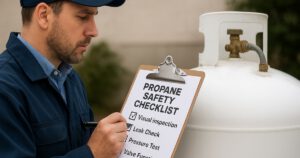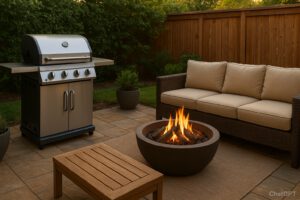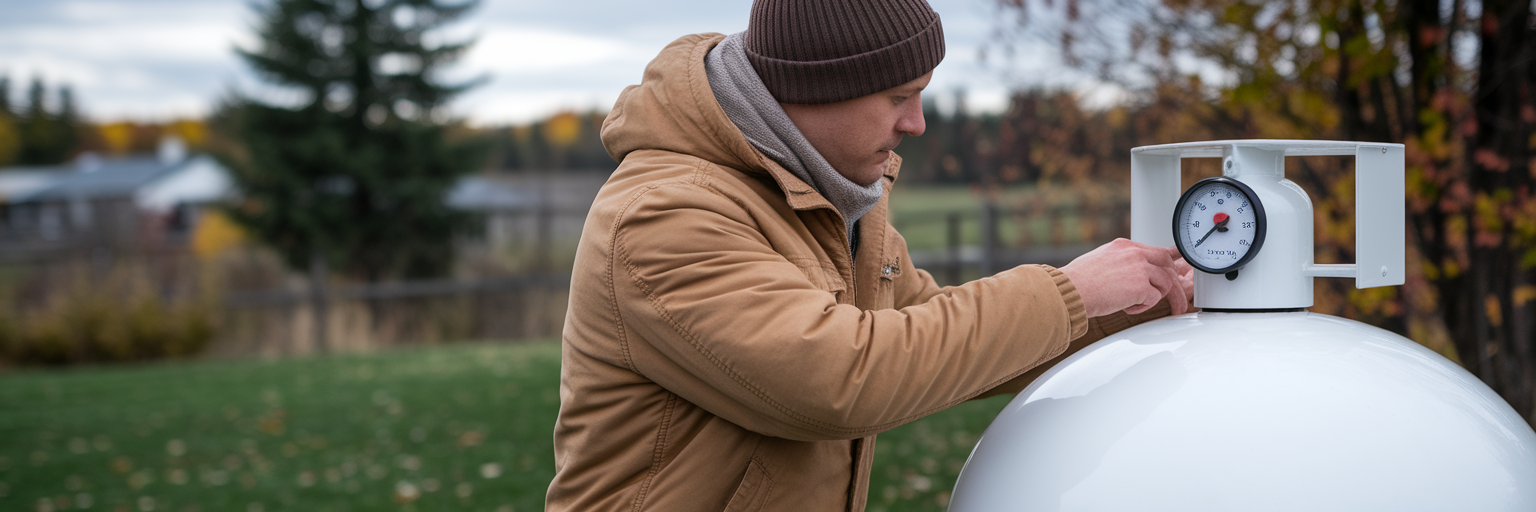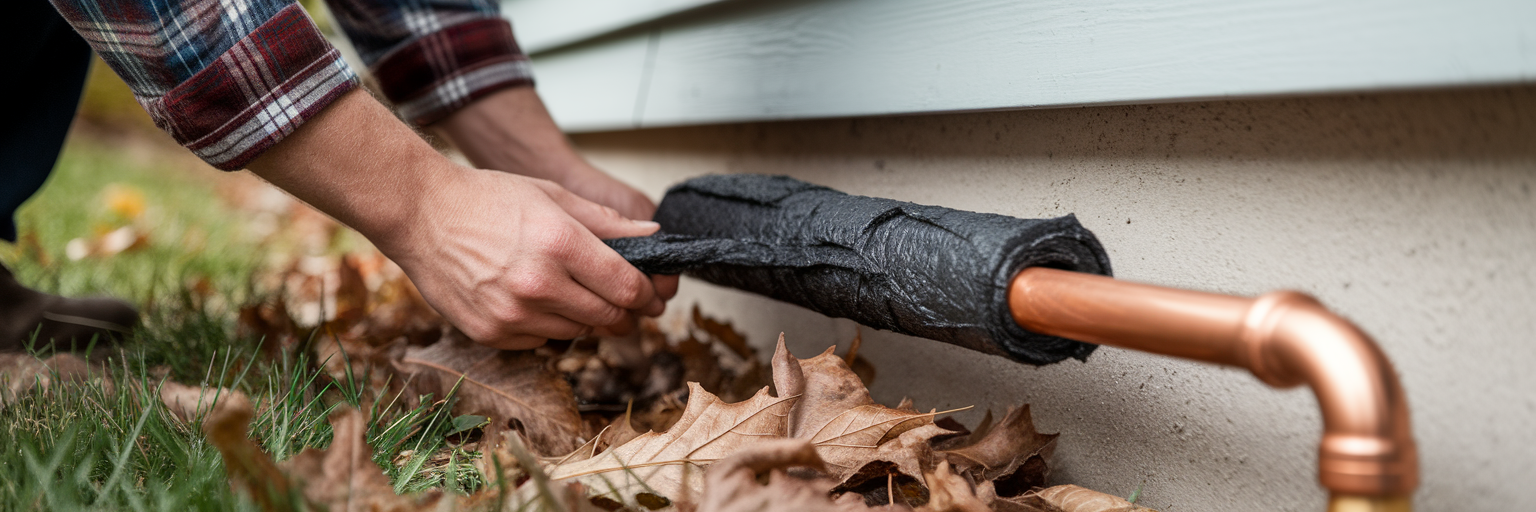
There’s a unique comfort in being inside a warm home, listening to a winter storm rage outside. For the millions of American households that rely on propane for heat, that feeling of security doesn’t happen by accident. According to the U.S. Census Bureau, over 5.7 million homes use propane as their primary heating fuel, making winter readiness a critical annual task.
As temperatures drop, your furnace and water heater work overtime, causing a significant increase in propane consumption. This is precisely why you need to prepare propane for winter. Ignoring your system can lead to serious problems, like running out of fuel during a blizzard or experiencing pressure drops that cause your appliances to fail just when you need them most.
Neglected equipment can also introduce safety issues. A system that works perfectly in mild weather might reveal its weaknesses under the strain of winter. This guide provides simple, clear steps to ensure your propane system is reliable, efficient, and safe, giving you peace of mind all season long. For a deeper look into best practices, you can learn more about general propane safety to stay fully informed.
Check Your Tank Level and Schedule a Refill
Before the first frost arrives, your most important task is managing your fuel supply. Start by checking your propane tank’s gauge. It’s the round dial on the tank, usually under a protective lid, that shows the fuel level as a percentage. Remember, a “full” tank reads around 80-85% to leave room for the gas to expand with temperature changes. This is a normal and important safety feature.
We strongly advise following the 30% rule. Never let your tank level fall below 30% during the winter. When the level gets too low in cold weather, the pressure inside the tank can drop, preventing the propane from vaporizing correctly and starving your appliances of fuel. A low tank is also more susceptible to moisture buildup, which can lead to rust and corrosion from the inside out.
Here’s what to do:
- Locate and read your tank gauge.
- If the level is at or approaching 30%, it’s time to act.
- Contact your supplier to schedule propane delivery for winter well before a storm is in the forecast. Suppliers get extremely busy during the first cold snap.
Many homeowners find that automatic delivery programs remove the guesswork. With this service, your supplier monitors your usage and schedules refills for you. If you’re looking for a new provider, choose one with a strong local reputation and 24/7 emergency service. You can use our locator to find a reliable propane supplier near you.
Conduct a Thorough Safety Inspection
Once your fuel supply is secured, the next step is a hands-on safety check. You don’t need to be a technician to spot potential problems. Start by walking around your tank and visually inspecting it. Look for significant rust, corrosion, or dents on the tank body and along the visible lines. While minor surface rust can be normal, deep corrosion or physical damage warrants a call to your propane professional.
Next, perform a “smell test.” Propane is naturally odorless, so suppliers add a chemical called mercaptan to give it a distinct “rotten egg” or sulfur-like smell. Walk near your tank and around your propane-powered appliances. If you detect this odor, it’s a non-negotiable sign of a potential leak. Your immediate steps should be to evacuate everyone from the area, avoid using any electronics or light switches, and call your propane supplier or 911 from a safe distance away. This simple test is a cornerstone of propane tank winter safety.
Finally, check the components on top of your tank. Your regulators and relief valves are vital for maintaining correct pressure. Make sure they are clear of any debris, leaves, or insect nests. Blockages can interfere with their function and create a dangerous situation. While these homeowner checks are important, we strongly recommend a professional inspection, especially if your system is older. A qualified technician can spot issues an untrained eye would miss, ensuring your entire system is sound for the winter.
Insulate Pipes and Protect System Components
A common question homeowners ask is what to insulate and what to leave exposed. Understanding the “why” behind the rules is key. Extreme cold lowers the pressure inside your propane tank, which can slow down the conversion of liquid propane into gas. If the pressure drops too much, it can reduce or stop the flow of fuel to your appliances. This is where knowing how to winterize propane tank components correctly becomes essential.
You should insulate any exposed propane lines, particularly those running through unheated areas like crawl spaces or along exterior walls. Foam pipe insulation sleeves, available at most hardware stores, are an easy and effective solution. Simply cut them to length and fit them over the pipes to protect them from the cold and help maintain consistent gas flow.
However, it is critical to never wrap or cover the main propane tank itself. This is a common but dangerous mistake. Covering the tank traps moisture against its surface, which accelerates rust and corrosion. It can also hide leaks or other damage from view and may interfere with the proper functioning of the safety relief valve. The tank is designed to be exposed to the elements.
| Component | Recommended Action | Reasoning |
|---|---|---|
| Exposed Propane Pipes | Insulate with foam sleeves | Prevents freezing and protects gas flow to appliances. |
| Propane Tank Body | Do NOT insulate or cover | Allows for proper ventilation and prevents moisture from being trapped, which causes corrosion. |
| Regulators and Valves | Keep clear of snow and ice | Ensures proper pressure regulation and allows safety valves to function correctly. |
Note: This table outlines general best practices for homeowners. Always consult a qualified propane professional if you are unsure about any modifications to your system.
Maintain Clear Access to Your Tank
Winter preparation extends beyond the tank itself to the area surrounding it. This is an often-overlooked step that is crucial for both service and safety. Your propane delivery driver needs a clear and safe path to access the tank. They handle heavy hoses and equipment, and navigating snow or ice can be hazardous. If they cannot safely reach your tank, they cannot make a delivery.
The same principle applies to emergency responders. In the unlikely event of an issue, they need immediate and unobstructed access. Plan to keep a path at least one foot wide clear of snow from your driveway to your tank.
When clearing snow directly from the tank, be gentle. Use a broom or a brush to sweep away snow and ice from the tank, regulators, vents, and lines. Never use a shovel or other hard or sharp object, as you could easily damage these critical components. Keeping vents clear is especially important for proper system operation. This simple maintenance is a key part of ensuring your residential propane setup is safe and serviceable throughout the winter. As a general safety rule, never store flammable materials like firewood, gasoline, or oily rags near your propane tank. For more information on our services, you can explore our residential propane solutions.
Your Winter Propane Preparedness Checklist
Getting your system ready for winter doesn’t have to be complicated. By following a few key steps, you can ensure your home stays warm and safe all season long. This simple propane system maintenance checklist consolidates the most important actions to take before the cold weather sets in.
- Check your tank gauge and keep the level above 30%.
- Schedule your winter propane delivery before the first cold snap.
- Visually inspect your tank and lines for damage and perform a “smell test” for leaks.
- Insulate exposed pipes, but never cover the tank itself.
- Keep the tank and a path to it clear of snow, ice, and debris.
Following these guidelines helps guarantee a reliable fuel supply and a properly functioning system. The ultimate benefit is a warm, worry-free home, even on the coldest days. When in doubt about any aspect of your propane system, always contact your local propane professional. Your safety is their top priority.
About Jennifer Whitaker
Propane industry expert and content contributor for MyPropane.com.
View all posts by Jennifer Whitaker →Related Articles

Essential Propane Safety Guide
Sep 17, 2025 • 6 min read
Learn essential propane safety tips, proper storage guidelines, leak detection, and emergency procedures to keep your family safe while using…

Propane Outdoor Kitchens and Living Spaces: Complete Guide
Sep 17, 2025 • 8 min read
Transform your outdoor space with propane-powered kitchens, grills, fire pits, and heaters. Learn about gas cooking advantages, safety features, and…

